In order to meet the expected increase in food demand without a massive expansion of cropland area, average crop yields will need to increase during the next three decades. Identifying and implementing the best management practices for major production environments are needed to meet this challenge.
Best management practices are for a given environment, consistently resulting in high yields with a reduction in downside yield. Issues such as adverse weather and pest damage cause reduced downside yield. The economic realities of farms create the need for these practices to be profitable. Exploring opportunities to increase their yield and profit and minimize production risks is something farmers are regularly exploring.
Weather and pest pressure during the growing season are unknown. This uncertainty then exists about which specific management practices and inputs will be needed. The uncertainty of this created with increased soybean prices and commercial marketing has encouraged soybean farmers to implement high-input management systems to protect and maximize yield and profitability.
The systems involve the prophylactic application of multiple inputs such as biological and pesticidal seed treatments, soil and foliar fertilizers and foliar pesticides regardless of the soil nutrient status or anticipated disease pressure.
High crop yields are very important however, production stability across regions and over time is important. Yield variance is a symmetric measure of variability around the mean and an important measure of production stability. Unusually low yields are often more problematic than unusually high ones. Thus, a key question is whether the prophylactic application of multiple inputs in high-input management systems better protects from yield loss compared to low-input management systems, i.e., does it lower downside yield risk?
The objective of this study was to measure the effect of high input management systems on soybean yield and risk by analyzing yield data from field experiments over the period 2009-2014 across the U.S (Figure 1). The high-input cropping system included fungicide, insecticide and biological seed treatments, soil and foliar fertilizer and foliar fungicide and insecticide applications. None of those inputs were applied in the low-input system.
The study examined two hypotheses: (I) high-input management systems consistently increase soybean productivity across the U.S. and (ii) high-input management systems are associated with lower yield risk as measured by the variance, skewness and kurtosis of soybean yield.
Reduced variance and increased skewness are desirable as they lead to lower risk exposure (from a lower variance) and lower exposure to unfavorable events implied by the lower tail of the yield distribution (higher skewness). Decreased kurtosis indicates a lower exposure to rare events in the tails of the desirable yield distribution. Our analysis documents the extent to which intensive soybean management contributes to high yield by reducing yield loss and risk exposure.
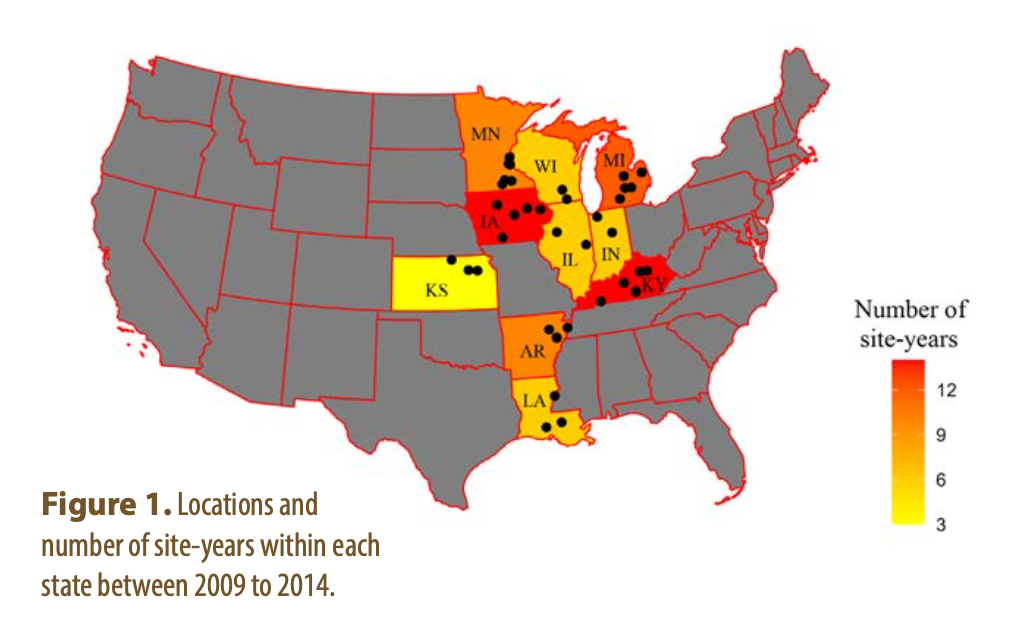 Source: University of Wisconsin-Madison Extension
Source: University of Wisconsin-Madison Extension
Materials and Methods
The study used yield data from replicated field experiments over the period 2009-2014 within 10 states. Within each experiment, two cropping systems were applied. The high-input cropping system included fungicide, insecticide and biological seed treatments, soil and foliar fungicide and insecticide applications. None of those inputs were applied in the low-input system. All experiments were non-irrigated and the same background management practices (e.g., tillage, previous crop, row spacing, seeding rate) were used for both systems.
The analysis relies on a moment-based approach by evaluating the mean, variance, skewness and kurtosis of soybean yield conditional on the state (average of all locations in a state) and cropping system. Mean yield reflects the average productivity of each cropping system in each state. The variance captures the variability of soybean yield around its mean. The skewness measures the asymmetry of the yield distribution, with a negative skewness capturing exposure to losses located in the lower tail of the distribution (downside risk). The kurtosis measures the thickness in the tails of the distribution of soybean yield. A large kurtosis is associated with a high risk because it indicates a high probability of extreme yields (low and high).
Results
High-input management systems increased soybean yield compared to low-input systems within each of the examined states, apart from Kansas (Figure 2). In those states, the estimated probability of a positive yield difference (high- minus low-input management systems) was 97%. The realized yield increases ranged between 6.3-12.7% of the average yield, with the largest yield benefits observed in northern states (MN and WI). The only state where high-input management did not increase yield compared to low-input management was Kansas.
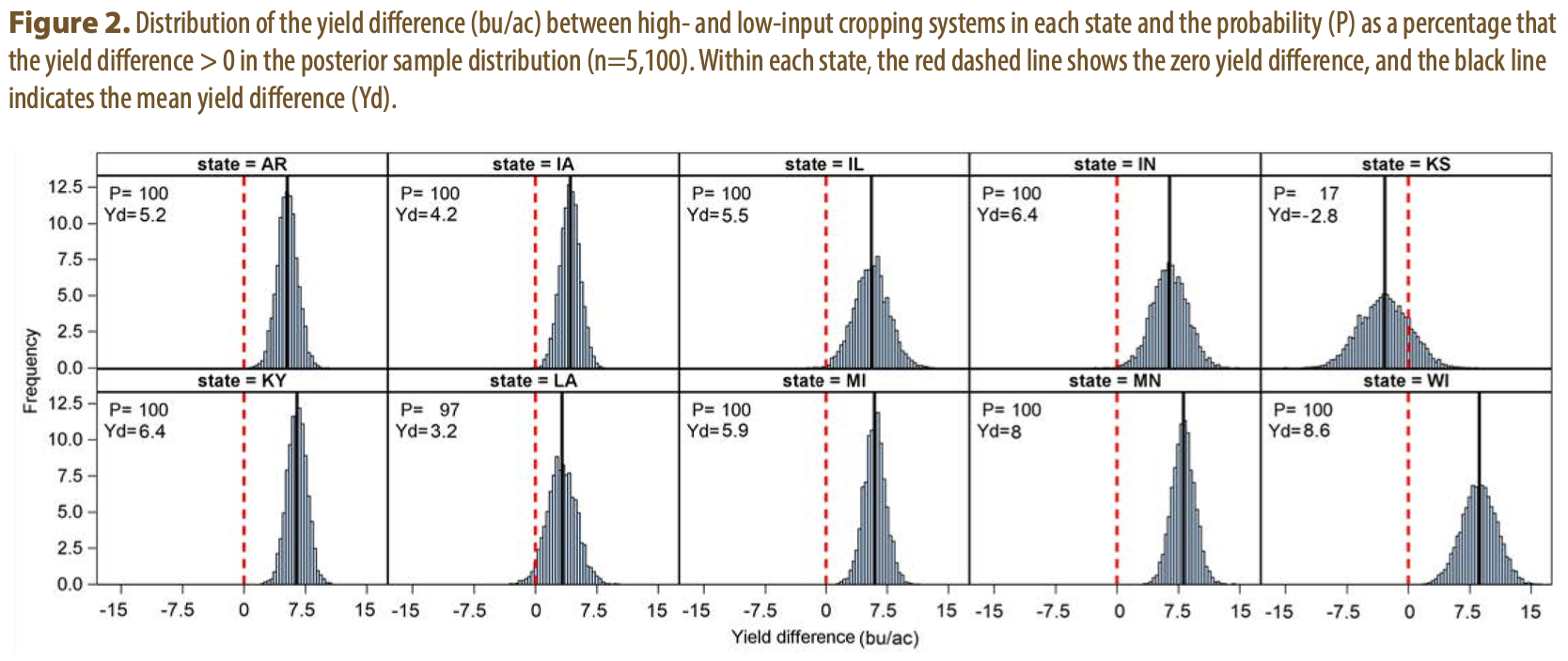 Source: University of Wisconsin-Madison Extension
Source: University of Wisconsin-Madison Extension
The analysis shows that high-input management had effects on yield variance that varied by state (Figure 3). In Arkansas, Minnesota and Louisiana, low-input systems had a more significant yield variance than high-input systems. In contrast, the opposite was observed in other states apart from Kansas where the two systems exhibited similar yield variance. Apart from Kentucky, where the variance for the low-input system decreased, the observed differences were insignificant. These results show that intensive soybean management only sometimes reduces yield risk across the examined growing environments.
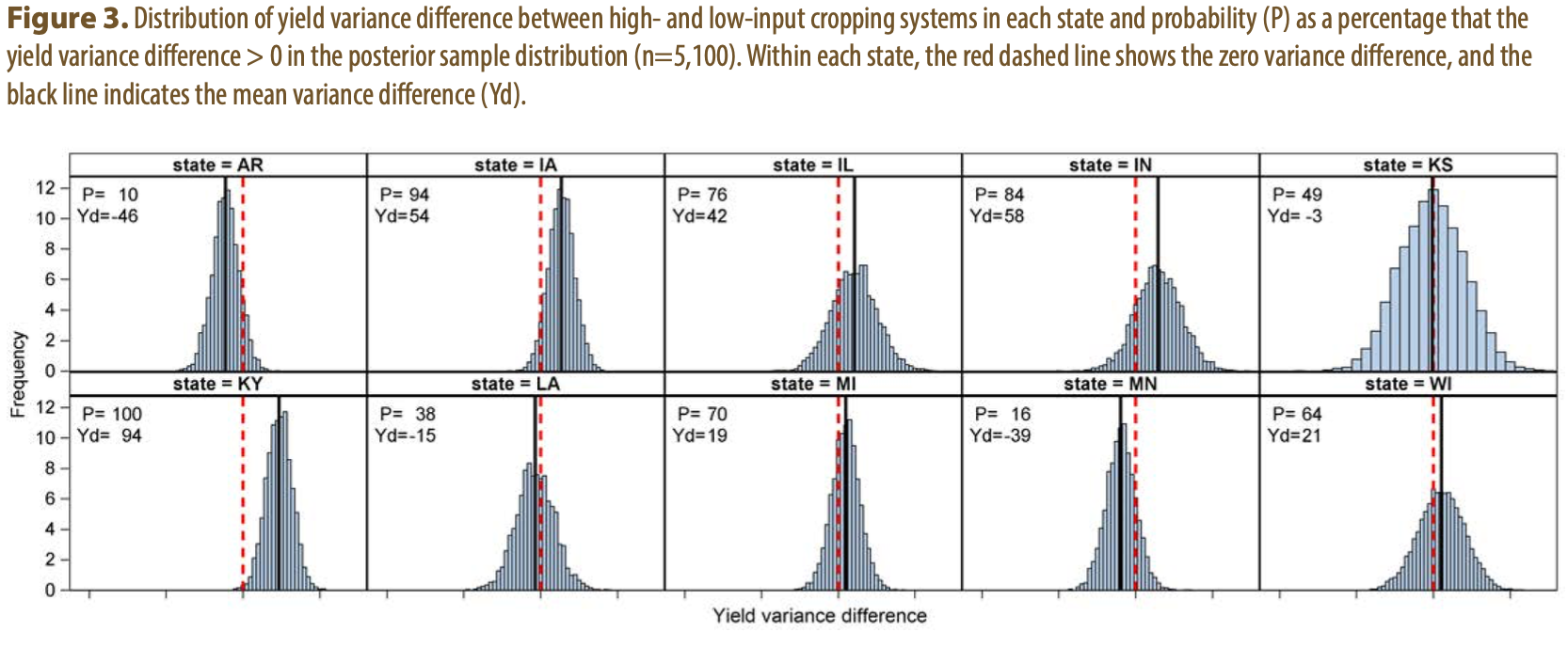 Source: University of Wisconsin-Madison Extension
Source: University of Wisconsin-Madison Extension
Next, the study investigates differences in yield skewness and kurtosis between systems. For yield skewness, high-input systems slightly increased yield skewness in Iowa, Illinois, Indiana and Kansas (Figure 4), implying lower risk of unusually low yields, while in Arkansas, Louisiana and Wisconsin, the yield skewness decreased.
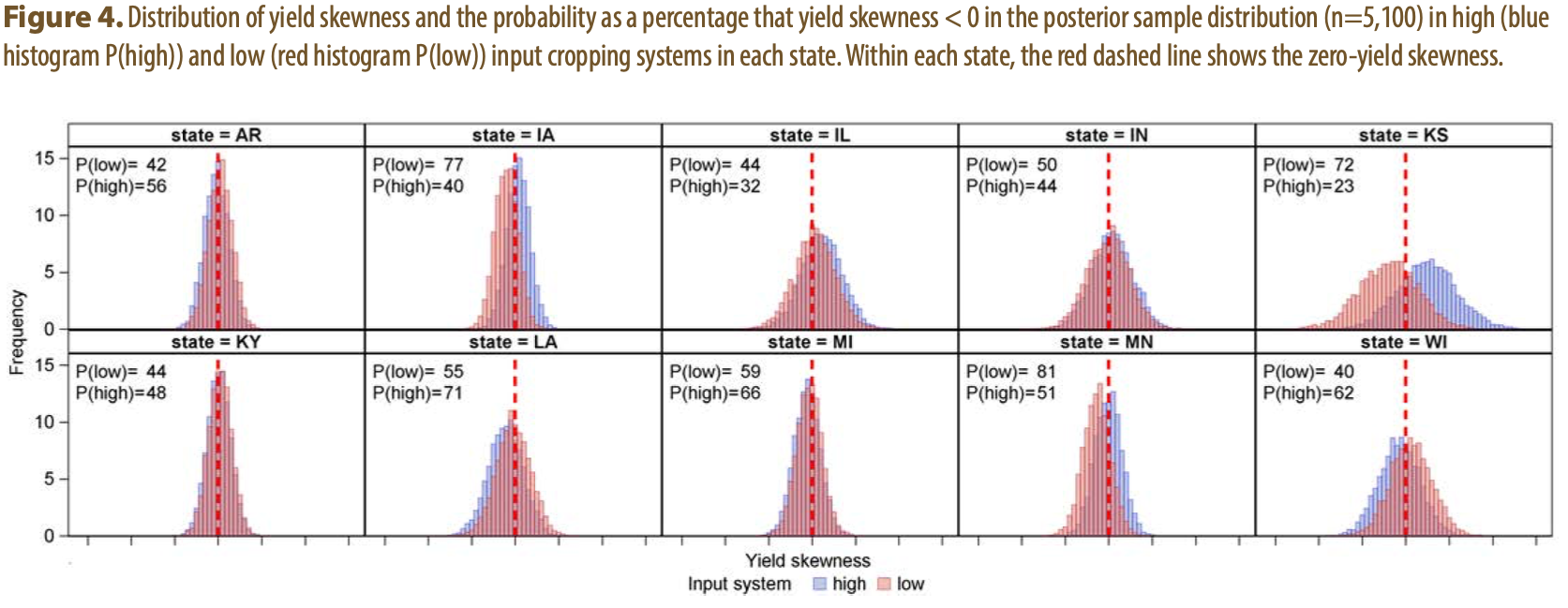 Source: University of Wisconsin-Madison Extension
Source: University of Wisconsin-Madison Extension
However, the effects were not significant, suggesting little empirical support that yield skewness changes significantly when using high-input management systems. For yield kurtosis, high-input systems exhibited lower kurtosis than low-input systems in Arkansas, Kansas, Louisiana and Minnesota, suggesting lower risk exposure to the tails of the distribution (Figure 5).
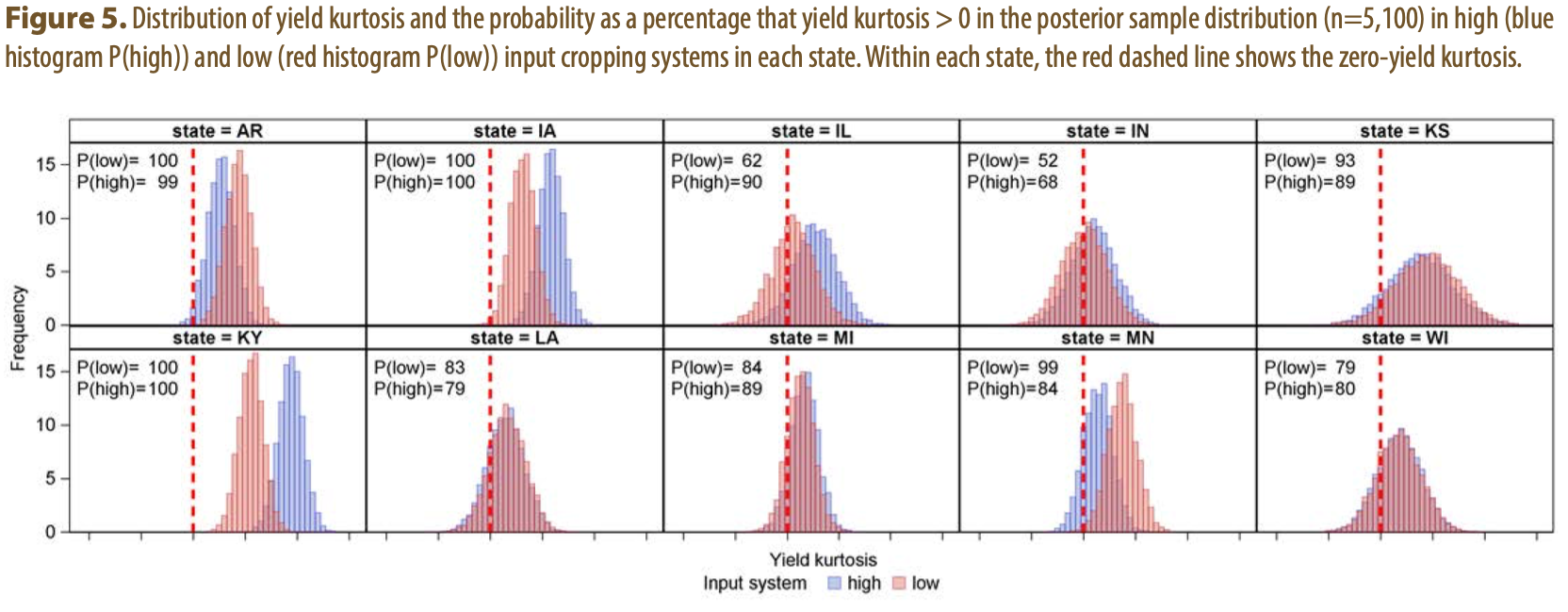 Source: University of Wisconsin-Madison Extension
Source: University of Wisconsin-Madison Extension
The opposite was observed in Iowa, Illinois, Indiana, Kentucky and Michigan and no clear evidence of kurtosis differences was observed in the remaining states. Again, apart from Arkansas, Iowa, Kentucky and low-input systems in Minnesota, the results provide little empirical support that yield kurtosis changes significantly when using high-input management systems. Overall, results suggest that soybean management contributions to reducing low yields or rare yield events depend on the growing environment.
To evaluate the importance of the observed effects of management intensity on the yield distribution, the researchers calculated the cost of risk (measured as bu/ac of soybean yield) by assuming a moderately risk-averse and a highly risk-averse farmer. For a moderately risk-averse farmer (=3), the change in the total cost of risk between the high- and low-input systems was minimal, varying between -0.31-0.45 bu/ac (Figure 6) with no evidence that these differences were significant. The estimated mean costs of risk were less than 3% of their respective system-state-average yield.
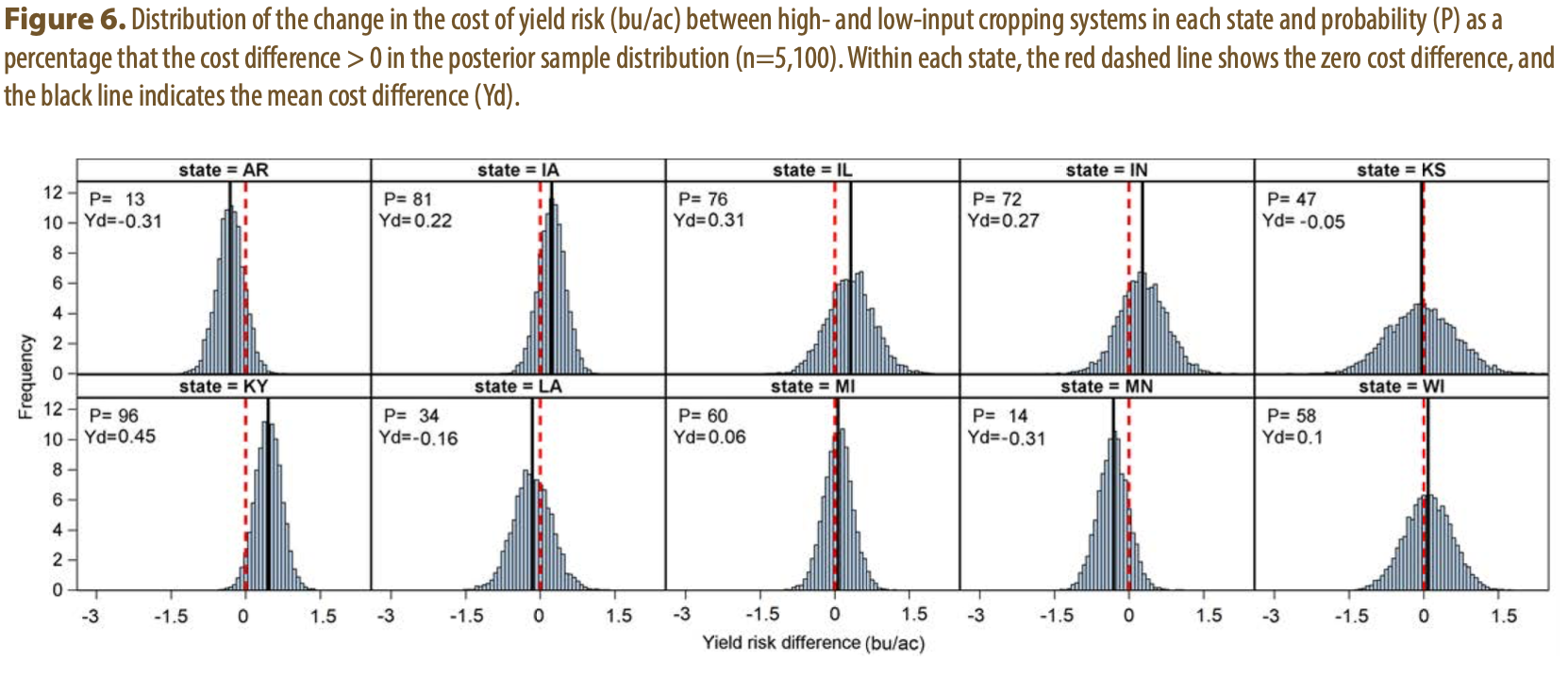 Source: University of Wisconsin-Madison Extension
Source: University of Wisconsin-Madison Extension
Discussion
U.S. farmers have become more interested in using multiple inputs in their soybean systems due to increased soybean prices, coupled with hypothesized nutrient deficiencies, potential plant health benefits, perceived level of potential pest infestation, and industry promotion. As an insurance practice, farmers typically decide to apply many of these inputs well in advance of planting time when there is little to no information about the potential severity or even the presence of yield-limiting factors. Here the researchers detected a yield-increasing effect due to high-input systems which were inconsistent among the examined states (-2.8-8.6 bu/ac or -4.9-12.7% of average yield). Reducing the risk of crop failure and yield loss is desirable to farmers who rely on high and stable crop yields to ensure consistent profitability and business welfare. The researchers' risk analysis showed that the mean cost of the yield risk difference at the field level between high- and low-input systems in each state was minimal (< 3% of total yield) and inconsistent, suggesting that applying multiple inputs had little effect on reducing downside yield risk at the field level. Consistent with previous studies, we found that most of the cost of risk at the field level comes from the variance component and intensive management resulted in similar or increased variance compared to low-input systems. This result is consistent with the risk-increasing effect of pest management inputs noted in previous studies.
The effect of management intensity on field-level yield skewness and kurtosis showed non-significant and inconsistent effects across the states. That the high-input system used multiple inputs, some protective and some productive, may have contributed to finding inconsistent effects. Our analysis shows that intensive management increased mean soybean yield and may increase the variance of yield at the field level for many farmers, with no consistent effect on downside risk as measured by the higher moments of yield.
This analysis was at the field level for soybean production in isolation, but at the whole farm level, aggregate risk effects of high and low-input soybean systems can be different. Factors that may increase risk at the field level (such as high-input soybeans), can reduce risk in aggregate for a farm. For example, Hurley et al. (2004) showed that adopting Bt corn increased risk at the field level by increasing yield variance, but at the whole farm level, can increase or decrease farm risk depending on technology cost and how the farm adjusts the total area cropped. Also, farmers choose inputs to manage more than just yield or income risks, such as human and environmental safety or time and managerial simplicity.
Overall, these results suggest that the yield risk effects of intensive soybean management systems at the field level are not large and such systems should not necessarily be considered a broad-scale profitable and sustainable food-securing practice across the U.S. to reduce downside production loss risk. This is in agreement with recent work that showed that most of the management practices in the high-input system exhibited low-to-moderate importance in predicting soybean yield in major crop-producing regions in the U.S. The greatest yield benefits from high-input systems were observed in the northern states of Minnesota and Wisconsin (8 and 8.6 bu/ac, respectively). These mean yield increases accounted for a respective 12.7 and 12.1% of the average yield and can be considered substantial.
The multiple applied inputs are estimated to cost ca. 170 $/ac which means that the soybean price would need to exceed 20 $/bu to cover the cost of the application in Minnesota and Wisconsin, respectively. Such high prices have never been observed and therefore, these results question the profitability of broad-scale adoption of high-input soybean management across the US. We argue that identifying management with a high potential to consistently increase yield in specific regions will be more likely to result in profitable yield increases.
Conclusions
Overall results in this work show that when compared to low input application, intensifying soybean management is a yield increase without reducing downside yield loss risk. Additionally, the observed yield benefits indicate a negative return on investment which is consistent with previous studies. These results further support the use of integrated pest management (IPM) for making input decisions instead of relying on prophylactic input applications as insurance against yield-limiting factors. Such an approach can be cost-effective and environmentally friendly since inputs are applied when and where needed. We conclude that future studies of food security and crop production should be region-specific and focus on identifying management practices with the greatest yield potential based on IPM practices rather than recommending broad-scale intensive management systems as insurance practices.






Post a comment
Report Abusive Comment